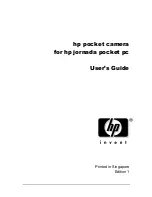
Pg. 1
Field Camera Workshop
Electronic Field Production (EFP):
“EFP” refers to equipment and techniques for recording video and audio at remote locations.
The equipment is compact, rugged, and designed for ease of use. EFP equipment frees the
video producer from the confines of the traditional TV Studio, and permits recording in more
interesting and less artificial locations.
This compactness also allows productions to be done by a very small technical crew, or even
just one person.
EFP equipment is commonly used for recording video and audio to be used in specific types
of programs, including interviews, documentaries, music videos, and news or magazine style
shows.
Video and audio recorded with EFP gear must normally be edited before it will be suitable to
watch. Because the “footage” you shoot will be edited, you don’t have to worry about erasing
or deleting bad shots from the camera; the editing system lets you easily toss out any “bad
takes” that you record, and rearrange the order of the various shots and scenes you videotape.
EFP cameras are poorly suited for certain kinds of “event” productions, like sports contests or
concerts, where there are many things happening simultaneously over a large area. If you wish
to shoot an event, talk with MetroEast Staff about using one of the multi-camera systems, like
Studio A or B, or the Mini-Mobile, Micro-Mobile.
The Camera:
The Panasonic AG-AC160 camcorder records high-quality digital video and audio on “flash
memory” cards. The camera comes equipped with 2 64-Gigabyte SDHC cards which com-
bined can hold more than 10 hours of High Definition video in the standard setting.
Once recorded, the video and audio on the memory cards can be transferred to an editing
computer quickly. For example, if you completely filled one card with video (over 5 hours), it
would only require about 10 minutes to transfer the footage from the card to MetroEast’s Edit-
ing Storage system (the “SAN”).
This “Flash Memory” also allows quick and easy review of recorded material; simply select any
“clip” from tiny “thumbnails” on the LCD viewfinder. After review, you can immediately begin
recording again; no rewinding or fast forwarding is needed.
For sound, the camcorder has connections for attaching high-quality external microphones, or
connecting to existing sound systems often found in auditoriums, churches, or clubs.
The camera also provides automatic or manual control of most of the important functions of the
camera and recorder. Switch to “Auto” for Point-and-Shoot ease of use, or set the controls to
“Manual” for more precision control over color, contrast, or audio.
About This Handout:
This packet provides general information about what the various parts of the camera are for,
and how they apply to making video productions.
There is also a smaller companion booklet that offers a step-by-step guide to operation.


































